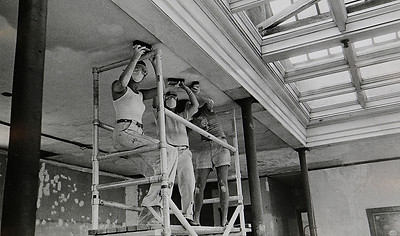

About
“I never wanted to be young. What I wanted was to have history.”[1]
“I was terrified of being born a woman and then I tried to straighten myself out.”[2]
Lina Bo Bardi
LINA magazine arises from the desire and need to create a space for discussion and reflection led by women within the spheres of architecture and urban planning. We intend to build this space from intersectional and transdisciplinary feminist perspectives, especially oriented to question and deconstruct the false notion of male neutrality perpetuated in these practices and in the associated theoretical constructions.
We name this project “LINA” as a femenage [3] to the Italian-Brazilian architect Lina Bo Bardi, whose architectural and editorial work (in the magazine A in Italy, and in the magazine Habitat, in Brazil) represent a significant contribution to professional practice, research and, above all, in the Herstory [4] of architecture. On the other hand, the choice of the magazine's name reflects a political position that articulates the personal experiences of the women who integrate the editorial team, as women of different nationalities residing in Portugal. In this sense, like Lina Bo Bardi, we believe in the importance of framing our reflections, albeit on architecture and urbanism, from our political subjectivities as immigrant women.
“Lina” also allows expressing another critical dimension that ironizes and reappropriates the (mostly male) strategy of assigning “women's names” to fashion and lifestyle magazines aimed at describing, disseminating and capitalizing on gender stereotypes, such as “Marie-Claire”, “Cristina”, “Maria”, etc. We start from this analogy of the diffusion of manifest gender stereotypes in editorial supports to illustrate our contextualized positioning in architecture (and in the arts, in general): we renounce the idea of artistic genius and the figure-God/Goddess, as well as the historically disseminated idea of women as muses of the creative subject (instead of creators themselves) and any other type of objectification, romanticization and mystification of women architects. As expressed in the practices of the architect Lina Bo Bardi, we defend the valorization of collective and multidisciplinary work in architectural and urban practices.
Despite the elitist historiography of the profession, we intend to discuss and expose theories, in addition to promoting egalitarian and intersectional thinking on the following themes: feminist and inclusive urbanism, sexism in the profession and in teaching, erasure and historical exclusion of women, feminisms, ecofeminism, gender violence, equality, care, right to the city, mobility, among other topics. We are interested both in the history and impact of women in the profession, as well as in the study of women as subjects who live in designed spaces.
We speak of “feminism” and “feminist perspectives” as a political position that we take. We recognize the repertoire of feminist struggles and theories that preceded us — and which we want to continue, using the space of this magazine as a vehicle for mobilization-discussion for this feat. We are aware that the prejudices historically produced under capitalist, patriarchal and colonial systems exist inside and outside the profession, which over time has hidden, if not erased, the stories of women (and other minorities), as creators and users of spaces , whether private or public. Thus, we do not want to occupy spaces within oppressive systems, but rather to deconstruct these systems, through a critical and diverse analysis of discourses on architecture and urbanism, and on their production.
We believe in sisterhood and collectivities among women, and beyond, in order to create a network of discussion and debate that aims to expand the study of spatial practices in the field of architecture and urbanism. We want to open dialogue and manage, in the same space or platform (of this magazine), to give voice to a multitude of subjects, students, architects, artists, teachers, through a horizontal / non-hierarchical approach, which breaks with the “starsystem” ” that constrains our profession.
References
[1] BARDI, Lina Bo. Curriculum literário. Em M. C. Ferraz (coord.), Lina Bo Bardi. São Paulo: Instituto Lina Bo e P. M. Bardi, 1993. p. 9
[2] Lina Bo Bardi em MANIR, Mônica. (2014). Da missa, a metade: Como a marxista Lina Bo Bardi usou o ritual católico para encerrar a revolta operária do feijão contra a soja brochante. Aliás. https://alias.estadao.com.br/noticias/geral,da-missa-a-metade,1578682242 [Consult. 5/10/2020].
[3]“féminine universelle” : it is a language invented by the French activist Typhaine D in 2016 for the play “Conte à Rebours” and which proposed to put all the words in the feminine as a way of questioning the “neutral masculine” and “universal ” and re-appropriating the French language, but it is a method applicable to Latin languages in general.
[4] The story presented from a feminist point of view, with feminist perspectives, first appearance of the term in 1962 in the USA, word play between “his”story (where “his” is the masculine pronoun) and “her”story (where “her” is the feminine pronoun).